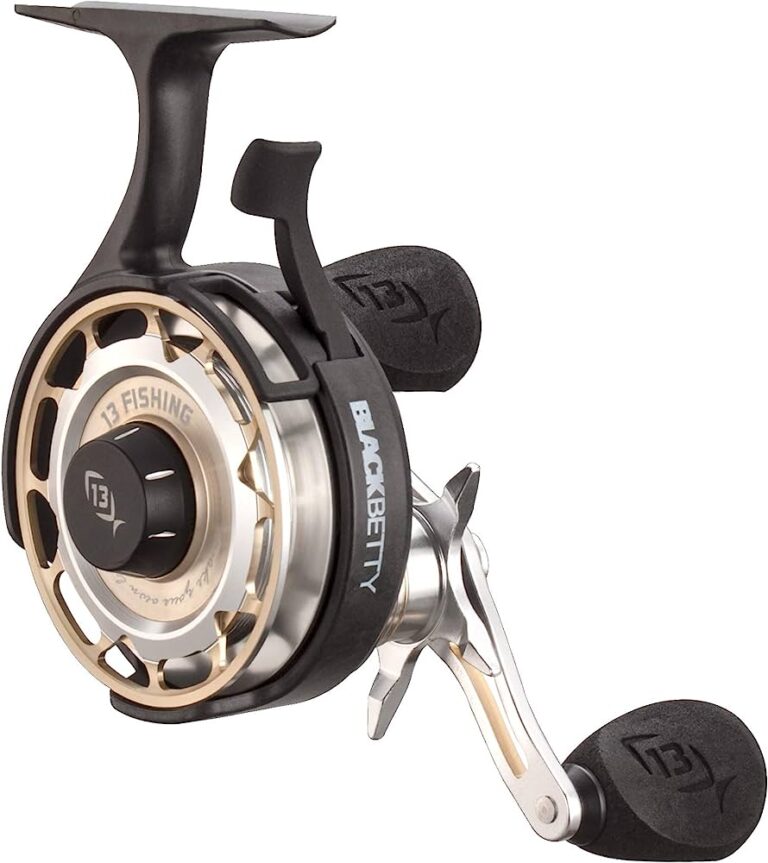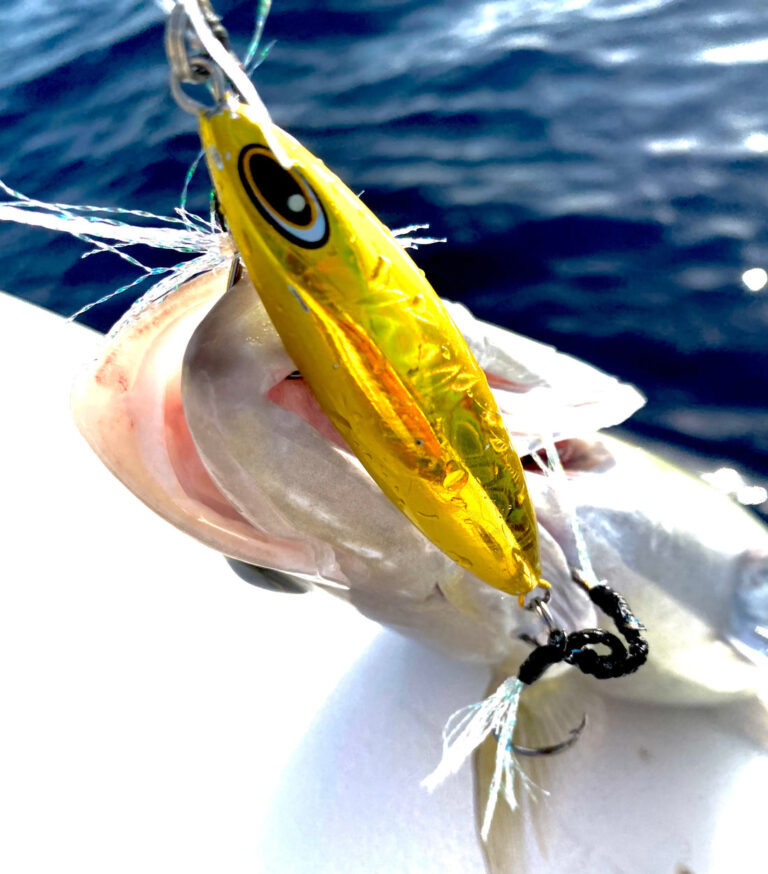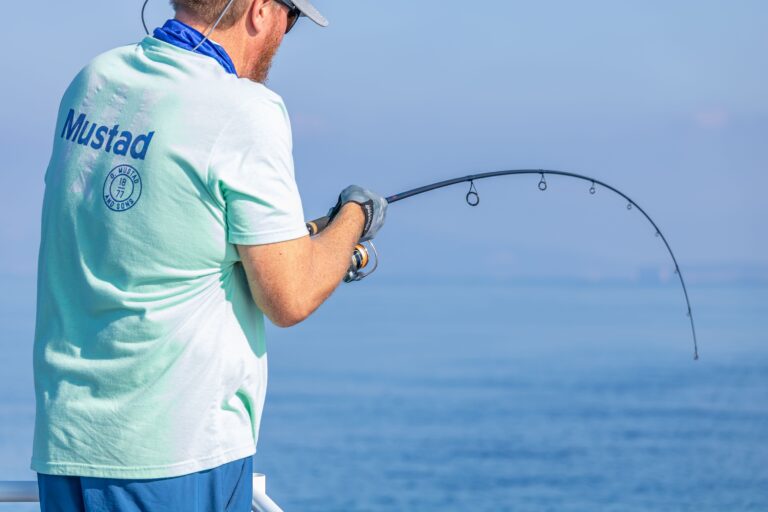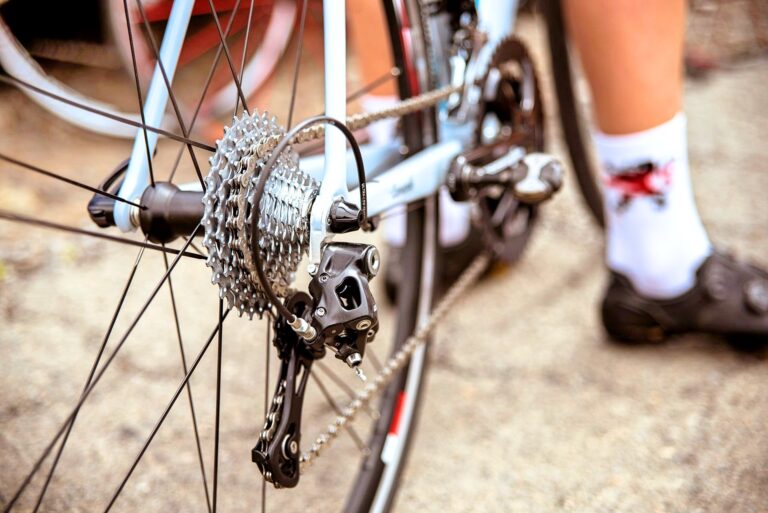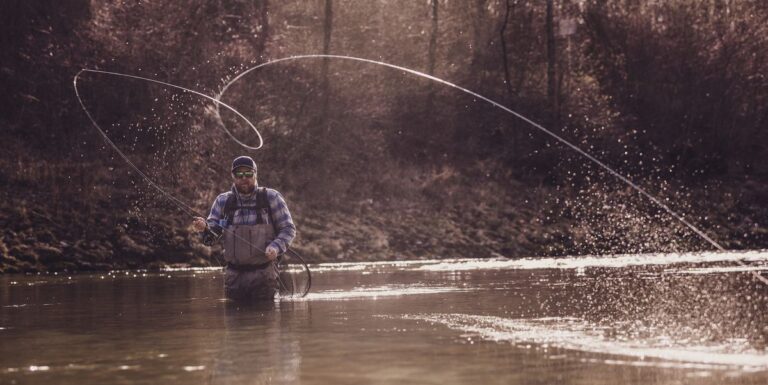The ideal length for a spinning rod is determined by the type of fishing and the target species. An accurate length for a spinning rod is typically between 6 to 7 feet, providing a good balance between casting distance and control.
With this length, anglers can easily cast light lures while maintaining enough power to handle medium-sized fish. It’s important to consider the specific fishing conditions and personal preferences when choosing the ideal length for a spinning rod. By refining the choice based on these factors, anglers can optimize their fishing experience and increase their chances of success on the water.
The length of the spinning rod is a crucial factor in achieving an effective and efficient fishing experience, allowing anglers to make accurate and powerful casts while maintaining control and sensitivity.

Credit: www.amazon.com
Why Does Rod Length Matter In Spinning Fishing?
When it comes to spinning fishing, the length of your rod can play a crucial role in your overall fishing experience. From casting distance to fish fighting power, the length of your spinning rod can greatly impact the success of your fishing endeavors.
Let’s explore why rod length matters in spinning fishing.
Factors Influencing Rod Length
The ideal length for a spinning rod can vary depending on several factors. Here are the key points to consider:
- Casting distance and accuracy: A longer spinning rod allows for longer casting distances, which can be advantageous when you’re trying to reach fish that are further away. However, a longer rod may sacrifice some accuracy in casting, as it can be more challenging to control. On the other hand, a shorter rod offers greater casting accuracy but may limit your casting distance.
- Line control and sensitivity: The length of your spinning rod affects your ability to control and feel your fishing line. A longer rod provides better line control, as it allows for wider swings and easier manipulation of the line. Moreover, longer rods offer enhanced sensitivity, making it easier to detect bites and subtle movements in the water.
- Fish fighting power: The length of your spinning rod also affects your ability to fight and land fish. A longer rod provides more leverage, allowing you to exert greater pressure on the fish and potentially tire it out more quickly. This can be advantageous when targeting larger, more powerful fish species. Conversely, a shorter rod may provide less leverage but offer better maneuverability in certain fishing situations.
Considering these factors, it’s important to strike a balance when selecting the length of your spinning rod. Many anglers find that a rod length between 6 and 7 feet is ideal for most spinning fishing scenarios as it offers a good compromise between casting distance, accuracy, line control, sensitivity, and fish fighting power.
By understanding how rod length impacts your fishing experience, you can make an informed decision when choosing the right spinning rod for your needs. Whether you prioritize casting distance, accuracy, line control, or fish fighting power, selecting the appropriate rod length is crucial in optimizing your fishing performance.
So next time you hit the water, ensure you have the ideal spinning rod length that suits your fishing style and target species. Happy fishing!
The Relationship Between Rod Length And Casting Performance
Choosing the right spinning rod length is essential to optimize your casting performance. The length of your rod plays a significant role in the distance, accuracy, and overall effectiveness of your casts. In this section, we will explore the ideal length for casting, the differences between short and long spinning rods, casting techniques, and considerations for different fishing environments.
The Optimal Length For Casting
- The ideal length for casting with a spinning rod typically ranges from 6 to 7 feet.
- Rods within this length provide a good balance between leverage, control, and casting distance.
- Longer rods may provide enhanced casting distance, but they can be more challenging to maneuver in tight spaces.
- Shorter rods, on the other hand, offer increased control but may limit your casting distance.
Short Vs. Long Spinning Rods
Short spinning rods:
- Ideal for close-quarter fishing situations and confined spaces.
- Allow for more precise casting and better accuracy.
- Suitable for casting lighter lures and targeting smaller fish species.
- Provide increased sensitivity, making it easier to detect bites.
Long spinning rods:
- Provide greater casting distance, making them ideal for open-water fishing.
- Allow for longer casts even with heavier lures.
- Offer better leverage for fighting larger fish.
- Preferred choice for surf fishing or when covering larger bodies of water.
Casting Techniques And Rod Length
The casting technique you use can influence the choice of rod length. Here are a few key factors to consider:
- Overhead casting:
- Longer rods are advantageous for overhead casting as they generate greater rod tip speed, resulting in longer casts.
- Shorter rods may require a more controlled casting approach, suitable for fishing in tight spaces or when precision is crucial.
- Sidearm casting:
- Medium-length rods are commonly used for sidearm casting.
- They provide a good combination of casting distance and maneuverability.
- Roll casting:
- Shorter rods excel in roll casting, especially when fishing in areas with obstacles or vegetation.
- Their shorter length allows for more precise roll casts.
Considerations For Different Fishing Environments
When selecting the ideal spinning rod length, it is crucial to consider the fishing environment and target species:
- Freshwater fishing:
- In smaller rivers, lakes, or ponds, shorter rods around 6 feet are commonly used for better control and accuracy.
- Longer rods around 7 feet are preferred for fishing in larger bodies of water, allowing for better casting distance.
- Saltwater fishing:
- Longer rods ranging from 7 to 9 feet are often used in saltwater environments.
- They provide the necessary casting distance when fishing from the beach, piers, or when targeting ocean species.
- Kayak fishing:
- Due to limited space on a kayak, shorter rods are often preferred for increased maneuverability.
- A rod length between 5 to 7 feet can provide better control and casting performance while fishing from a kayak.
Choosing the right spinning rod length is crucial for optimizing your casting performance. Consider your fishing style, target species, and fishing environment to determine whether a shorter or longer rod would be more suitable. Remember, there isn’t a definitive “ideal” length, but finding the right balance between leverage, control, and casting distance will enhance your overall fishing experience.
Finding The Right Rod Length For Your Fishing Style And Preferences
Finding the right rod length for your fishing style and preferences
Choosing the perfect length for different fishing techniques:
- Freshwater vs. saltwater fishing:
- Freshwater fishing:
- Longer rods allow for greater casting distance and better line control.
- Shorter rods offer more precision and maneuverability in close-quarters fishing.
- Saltwater fishing:
- Longer rods are advantageous for casting in open waters.
- Shorter rods are suitable for fishing in tighter spaces or while on a boat.
Pros and cons of shorter and longer rods:
- Shorter rods:
- Pros:
- Better accuracy and control in close-quarters fishing.
- Easier to transport and maneuver.
- Cons:
- Limited casting distance.
- Reduced line control in windy conditions.
- Longer rods:
- Pros:
- Increased casting distance, especially in open waters.
- Better line control, especially in windy conditions.
- Cons:
- Reduced maneuverability and precision in close-quarters fishing.
- More challenging to transport and store.
Rod length recommendations for specific fishing scenarios:
- Bass fishing:
- Recommended length: 6 to 7 feet.
- Longer rods offer greater casting distance for covering more water.
- Shorter rods provide better precision for targeting specific areas.
- Trout fishing:
- Recommended length: 7 to 8 feet.
- Longer rods allow for extended casting while maintaining control.
- Shorter rods provide better accuracy for delicate presentations.
- Surf fishing:
- Recommended length: 9 to 14 feet.
- Longer rods enable casting beyond breaking waves.
- Shorter rods are suitable for fishing closer to shore.
- Fly fishing:
- Recommended length: 8 to 9 feet.
- Longer rods provide better line control for accurate casting.
- Shorter rods offer increased maneuverability in tight spots.
- Crappie fishing:
- Recommended length: 5 to 7 feet.
- Longer rods allow for covering more water while trolling.
- Shorter rods are easier to handle when fishing from a boat or dock.
Remember, the ideal rod length for your fishing style and preferences depends on various factors. Consider the type of fishing you do, the environment you fish in, and your personal preferences for casting distance, line control, and maneuverability. Experimenting with different rod lengths can help you determine the perfect fit for your fishing adventures.
Understanding Fishing Environments And Conditions
Fishing is not a one-size-fits-all activity. Each fishing environment and condition requires a different approach, including the selection of the ideal spinning rod length. Understanding these factors will help you choose the right rod for your fishing needs.
Factors To Consider When Selecting Rod Length
When it comes to selecting the ideal length for a spinning rod, there are several factors you need to take into consideration. Let’s explore the main ones:
- Open water vs. Dense cover fishing:
- Open water fishing:
- Longer rods provide more casting distance.
- Increased length allows for better control when fighting fish.
- Dense cover fishing:
- Shorter rods are preferred for better maneuverability in tight spaces.
- Reduced length reduces the risk of snagging in vegetation or underwater obstructions.
- Fishing from shore vs. boat:
- Fishing from shore:
- Longer rods enable longer casts from the shore to reach the desired fishing spot.
- Increased length helps to overcome obstacles such as rocks or steep banks.
- Fishing from a boat:
- Shorter rods are more manageable in the confined space of a boat.
- Reduced length allows for better accuracy when casting around structure or cover.
- Windy or calm conditions:
- Windy conditions:
- Longer rods offer increased leverage to cast against the wind.
- Extended length helps to keep the fishing line away from the angler to avoid tangles.
- Calm conditions:
- Shorter rods are advantageous for precise casting in calm water.
- Reduced length provides better sensitivity to detect subtle bites.
Considering these factors will help you narrow down the ideal spinning rod length for your specific fishing situation. Whether you’re fishing in open water or dense cover, from shore or a boat, or in windy or calm conditions, selecting the right rod length is crucial for a successful fishing trip.
Analyzing Target Fish Species And Fishing Techniques
Spinning rods come in a variety of lengths, and choosing the ideal length for your fishing needs can greatly impact your success on the water. If you’re wondering how to determine the correct length for your spinning rod, consider analyzing target fish species and fishing techniques.
This will help you narrow down your options and make an informed decision. Let’s delve into some rod length recommendations for popular fish species and fishing techniques.
Rod Length Recommendations For Popular Fish Species
When selecting a spinning rod, it’s essential to consider the specific fish species you’ll be targeting. Different fish species have varying preferences when it comes to rod length. Here are some recommendations for bass fishing, trout fishing, and surf fishing:
Bass Fishing
- A medium to medium-heavy spinning rod in the range of 6’6″ to 7’2″ is ideal for bass fishing.
- This length provides the necessary power to handle larger bass while maintaining sensitivity for detecting subtle strikes.
- Shorter rods offer better maneuverability in tight spaces and are suitable for fishing around cover, whereas longer rods provide increased casting distance.
Trout Fishing
- For trout fishing, a lighter spinning rod in the range of 5’6″ to 6’6″ is preferred.
- Shorter rods allow for precise presentations in small streams and creeks, while slightly longer rods offer better casting distance in larger bodies of water.
- Opt for a light or ultralight power rod to enjoy the thrill of fighting trout while ensuring sensitivity to detect delicate bites.
Surf Fishing
- Surf fishing requires longer rods to cast beyond the breaking waves and reach deeper waters.
- A spinning rod between 9′ to 12′ in length is recommended for surf fishing.
- Longer rods provide the necessary leverage to launch heavy lures or baits into the surf and help control large fish when reeling them in.
Matching Rod Length With Specific Fishing Techniques
Apart from considering the target fish species, it’s important to match the rod length with the fishing techniques you’ll be utilizing. Here are some pointers for jigging and bottom fishing, casting and retrieving, and float fishing and trolling:
Jigging And Bottom Fishing
- Opt for a shorter spinning rod, around 6′ to 7′, when jigging or bottom fishing.
- A shorter length allows for better control and sensitivity when working lures or baits vertically.
- Additionally, shorter rods make it easier to detect subtle bottom structure changes or strikes.
Casting And Retrieving
- To maximize casting distance and accuracy, select a longer spinning rod in the range of 6’6″ to 7’6″.
- Longer rods generate higher rod-tip speeds, enabling you to cast your lures or baits further with ease.
- They also provide better line control during the retrieve, allowing you to manipulate your bait and entice fish to strike.
Float Fishing And Trolling
- When float fishing or trolling, longer spinning rods in the range of 7’6″ to 9′ offer the needed reach and control.
- Longer rods aid in navigating the float or lure through different depths and currents.
- They provide better line management and help in setting the hook efficiently when targeting fish at a distance.
Consider both the target fish species and fishing techniques you plan to employ when selecting the ideal length for your spinning rod. This careful analysis will help you optimize your fishing experience and increase your chances of landing that trophy fish.
Happy angling!
The Influence Of Rod Action And Power On Length Selection
Understanding Rod Action And Power
Rod action and power play a crucial role in determining the ideal length for a spinning rod. Understanding these factors is essential for selecting the right rod that will enhance your fishing experience. Here are key points to consider:
- Fast, medium, and slow action: Rod action refers to how much the rod bends when pressure is applied. Fast action rods bend less in the top third portion, providing greater sensitivity and allowing for quick hook sets. Medium action rods bend all the way to the middle, offering a balance between sensitivity and flexibility. Slow action rods bend throughout the length, making them ideal for lighter baits and fish fighting.
- Ultralight, light, medium, and heavy power: Power, on the other hand, determines a rod’s strength and resistance to bending. Ultralight rods are designed for small fish and delicate presentations, while light rods are suitable for smaller freshwater fish. Medium power rods are versatile, catering to a wider range of fishing applications, while heavy power rods are designed for larger fish or heavy cover situations.
Finding The Right Balance Between Action, Power, And Length
When choosing a spinning rod, striking the right balance between action, power, and length is crucial. Consider the following points:
- Action and sensitivity: For anglers seeking greater sensitivity, a fast action rod would be ideal. This allows for better feel and detection of subtle bites, making it well-suited for finesse techniques such as dropshotting or light jigging. However, if you prioritize casting distance or prefer a rod that loads up more during a fight, a slower action rod may be a better fit.
- Power and fish fighting ability: A rod’s power directly affects its ability to fight and control fish. Heavy power rods offer the strength needed to battle big game fish or handle heavy cover situations. However, using a heavy power rod for smaller fish can result in diminished sensitivity and a less enjoyable fishing experience. It’s important to match the power of the rod to the size and species of the fish you’re targeting.
Choosing The Right Combination For Your Fishing Goals
To optimize your fishing experience, it’s essential to select the right combination of action, power, and length. Here’s what you should consider:
- Fishing technique: Different fishing techniques require specific rod characteristics. For example, finesse techniques benefit from a sensitive, fast action rod, while heavier techniques like flipping or frogging may require a heavier power rod with more backbone.
- Target species: The size and species of fish you plan to target should dictate the power and action of your spinning rod. Smaller fish and finesse techniques generally pair well with lighter rods, while larger fish and heavier techniques call for more powerful rods.
- Fishing environment: The fishing environment, such as freshwater or saltwater, can influence the choice of rod length and material. Longer rods offer increased casting distance, while shorter rods provide better maneuverability in tight spaces.
By considering these factors and finding the right combination of action, power, and length, you can enhance your fishing experience and increase your chances of success on the water.
Assessing Personal Fishing Style And Experience
When it comes to choosing the ideal length for a spinning rod, it’s important to consider your personal fishing style and experience. Factors such as comfort level, casting style, personal experience, and skill level can all play a role in determining the best rod length for you.
Let’s take a closer look at how these factors can influence your decision:
Tailoring Rod Length To Your Fishing Preferences
- Different fishing techniques require different rod lengths. For example, if you prefer finesse fishing or are targeting smaller fish, a shorter rod between 6 and 7 feet may be more suitable. On the other hand, if you enjoy casting longer distances or pursuing larger fish, a longer rod between 7 and 9 feet may be a better choice.
- Consider the type of water you’ll be fishing in. If you frequently fish in tight spaces with heavy foliage or trees, a shorter rod can give you more control and maneuverability. Alternatively, if you often fish in open water or need to cast far distances, a longer rod can provide you with the necessary leverage and reach.
- Think about the species of fish you usually target. Smaller fish can be effectively caught with a shorter rod, while larger fish may require the added power and leverage of a longer rod. Tailoring your rod length to the fish you’re targeting can enhance your overall fishing experience.
Comfort Level And Casting Style
- Your comfort level plays a significant role in the success of your fishing trips. A spinning rod that feels comfortable in your hand and suits your casting style can improve your accuracy and casting distance.
- Consider the weight of the rod. Lighter rods are generally more comfortable to hold and cast over long periods. However, if you prefer a heavier rod for added power and control, make sure it’s still comfortable for your casting style.
- Determine whether you prefer a slower or faster action rod. Slower action rods bend the entire length of the rod, which can be advantageous for casting accuracy and sensitivity. Alternatively, faster action rods bend more towards the tip, providing greater power for casting longer distances.
Personal Experience And Skill Level
- Beginners may find it easier to handle shorter rods as they offer more control and are less likely to tangle or snag. A shorter rod can also help beginners develop proper casting techniques before moving on to longer rods.
- Experienced anglers may have a preference for longer rods, as they offer increased casting distance and leverage when battling larger fish. Longer rods can also provide better line control and mending abilities in certain fishing situations.
- Consider your overall fishing skill level when selecting a rod length. If you’re confident in your abilities and cast accurately, a longer rod may enhance your performance. However, if you’re still mastering your casting technique, a shorter rod can contribute to a more consistent and enjoyable fishing experience.
Balancing Versatility And Specialized Fishing Needs
- It’s important to strike a balance between versatility and specialized fishing needs when choosing a spinning rod length. A versatile rod length, such as a 7-foot rod, can handle a variety of fishing techniques and fish species. This makes it a great choice if you enjoy exploring different fishing styles or frequently fish in various environments.
- However, if you have specific fishing needs, such as targeting a particular species or using a specific technique, a specialized rod length may be more suitable. Specialized lengths can offer advantages in specific fishing scenarios, such as longer rods for distance casting or shorter rods for finesse techniques.
The ideal length for a spinning rod depends on various factors, including your fishing preferences, comfort level, casting style, personal experience, and skill level. Consider these factors when selecting a rod length to ensure an enjoyable and successful fishing experience.
Remember, there is no one-size-fits-all answer, and the right rod length for you may vary depending on your unique fishing style and needs.
Evaluating Equipment Compatibility And Portability
When it comes to selecting the ideal length for a spinning rod, evaluating equipment compatibility and portability is crucial. By considering factors such as rod length and reel size compatibility, balancing weight and balance, and storage and transportation limitations, you can ensure that your fishing gear is optimized for both performance and convenience.
Rod Length And Reel Size Compatibility:
- Matching the rod length and reel size is essential for achieving a well-balanced setup. Consider the following points:
- Longer rods provide increased casting distance and better line control, making them suitable for open water fishing.
- Shorter rods offer more maneuverability and are ideal for close-quarters fishing or targeting smaller species.
- Ensure that the reel size matches the rod length to maintain proper balance and ease of use.
Balancing Weight And Balance:
- The weight and balance of a spinning rod play a crucial role in its overall performance. Keep these considerations in mind:
- Lightweight rods reduce fatigue during long fishing sessions and allow for longer, more accurate casts.
- Balance the rod by selecting a reel that complements its weight and feel. This ensures a comfortable and efficient fishing experience.
Considering Storage And Transportation Limitations:
- Portability is a key factor, especially for anglers who frequently travel or have limited storage space. Take note of the following:
- Longer rods may be more challenging to transport and store, requiring additional considerations such as rod tube length and car trunk space.
- Collapsible or telescopic rods offer enhanced convenience, as they can be easily stored and transported in compact sizes.
- Evaluate the portability of the rod based on your fishing needs and logistical constraints.
Remember, finding the ideal length for a spinning rod goes beyond personal preferences. Take into account the compatibility between rod length and reel size, balance, and the practicality of storage and transportation. By carefully evaluating these factors, you can ensure that your fishing equipment is optimized for success on the water, while also catering to your convenience and comfort.
So, choose wisely and get ready for an enjoyable and efficient fishing experience!
Budget-Friendly Options And Quality Assurance
What Is The Ideal Length For A Spinning Rod
Exploring Various Price Ranges And Brands
When it comes to choosing the ideal length for a spinning rod, budget-friendly options are a consideration for many anglers. Fortunately, there is a wide range of price points and brands available in the market today. Here are some key points to consider:
- Entry-level brands: If you’re new to fishing or on a tight budget, there are entry-level brands offering spinning rods at affordable prices. These rods usually range from 5 to 6 feet in length and are suitable for light to medium freshwater fishing. While they may lack some advanced features, they can still provide a decent fishing experience.
- Mid-range brands: Many mid-range brands offer spinning rods in various lengths, catering to different fishing styles and preferences. These rods typically range from 6 to 7 feet in length and offer a good balance between affordability and quality. They often come with enhanced features such as better sensitivity, improved materials, and increased durability.
- High-end brands: If you’re willing to invest in a top-quality spinning rod, high-end brands are worth considering. These brands often offer rods in lengths of 7 feet or more, providing superior casting distance and accuracy. They are built with premium materials and advanced technologies, resulting in exceptional performance and durability.
Understanding The Relationship Between Price And Quality
When it comes to spinning rods, there is a clear relationship between price and quality. Here are some points to keep in mind:
- Higher price doesn’t always mean better quality: While high-end spinning rods offer superior performance, it doesn’t mean that budget-friendly options are inadequate. Many affordable rods on the market still provide satisfactory performance for casual anglers or beginners.
- Quality materials matter: One of the factors that influence the price of a spinning rod is the materials used in its construction. High-end rods often utilize advanced materials such as carbon fiber or graphite, which offer increased sensitivity, strength, and lightness. However, budget-friendly rods may still utilize cheaper materials that can provide sufficient performance for specific fishing scenarios.
- Matching your needs: The ideal spinning rod length depends on your fishing style and the target species. While high-end rods offer versatility and are suitable for various fishing situations, budget-friendly options can still meet specific fishing requirements. It’s essential to choose a rod that matches your fishing goals, rather than solely focusing on the price tag.
Evaluating Customer Reviews And Expert Opinions On Rod Length
To ensure that you make an informed decision when choosing the ideal length for a spinning rod, it’s crucial to consider customer reviews and expert opinions. Here’s what you should keep in mind:
- Customer reviews: Reading customer reviews provides valuable insights into the performance and durability of spinning rods. Look for common feedback points regarding the length and overall functionality of the rod to gauge its suitability for your needs.
- Expert opinions: Experts in the fishing industry can provide valuable recommendations on the ideal length for a spinning rod based on specific fishing scenarios. Their knowledge and experience can guide you in making an informed decision.
When considering the ideal length for a spinning rod, it’s essential to explore various price ranges and brands. Understanding the relationship between price and quality is crucial, as well as evaluating customer reviews and expert opinions. By taking these factors into account, you can find a spinning rod that matches your budget and fishing requirements.
Conclusion
Determining the ideal length for a spinning rod depends on various factors such as the type of fishing, target species, and personal preference. Understanding these factors is crucial in selecting the most suitable rod length. Shorter rods generally offer better control and accuracy in close quarters, while longer rods provide better casting distance.
Moreover, a shorter rod is ideal for beginners as it provides an easier learning curve. On the other hand, experienced anglers may prefer longer rods for increased reach and better line management. It is important to consider the weight, balance, and material of the rod as well as the fishing environment when making a decision.
Ultimately, finding the right rod length is a matter of personal choice and experimentation. Take into account these considerations, and you’ll be well on your way to selecting the perfect spinning rod for your fishing adventures.

